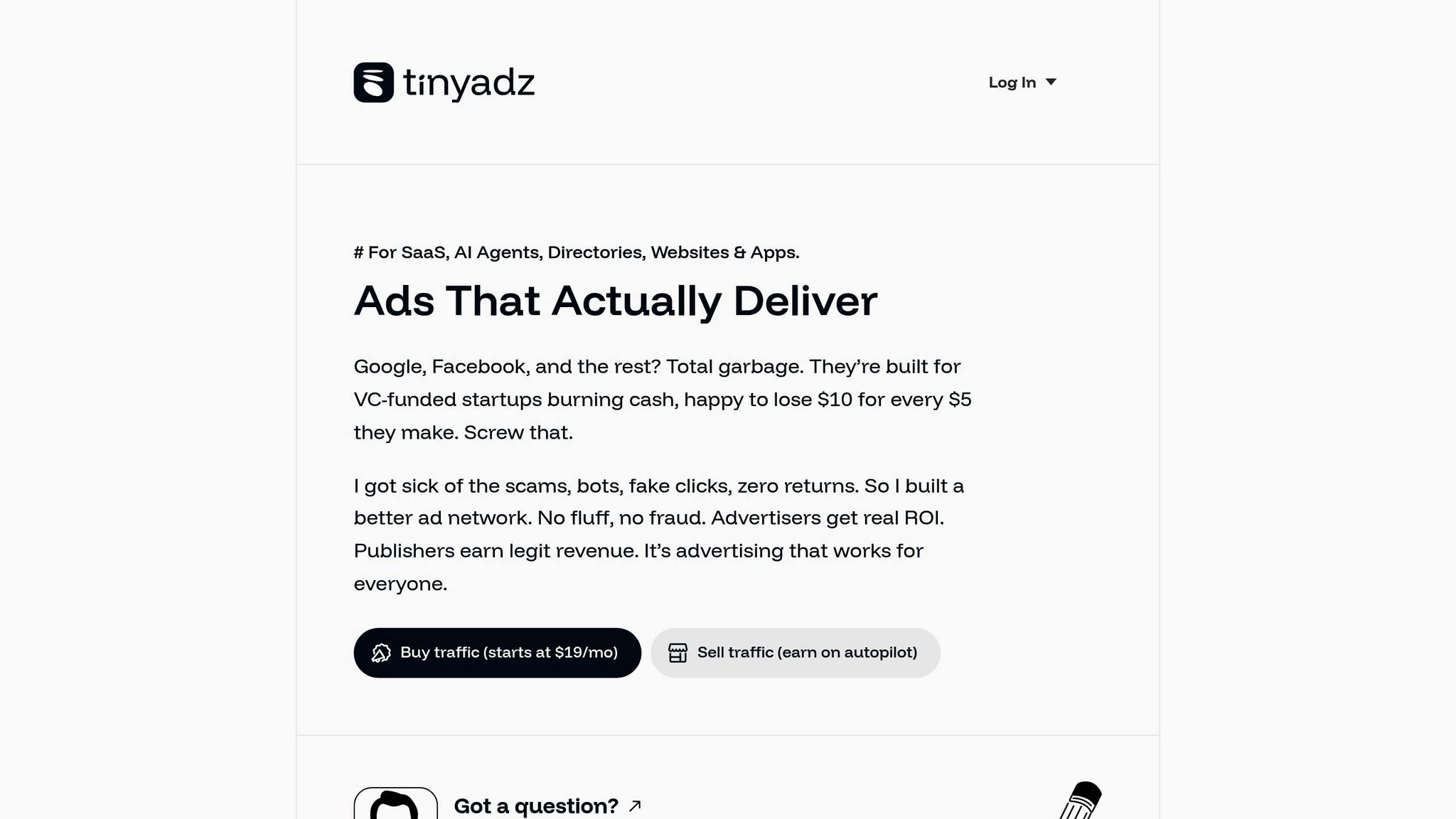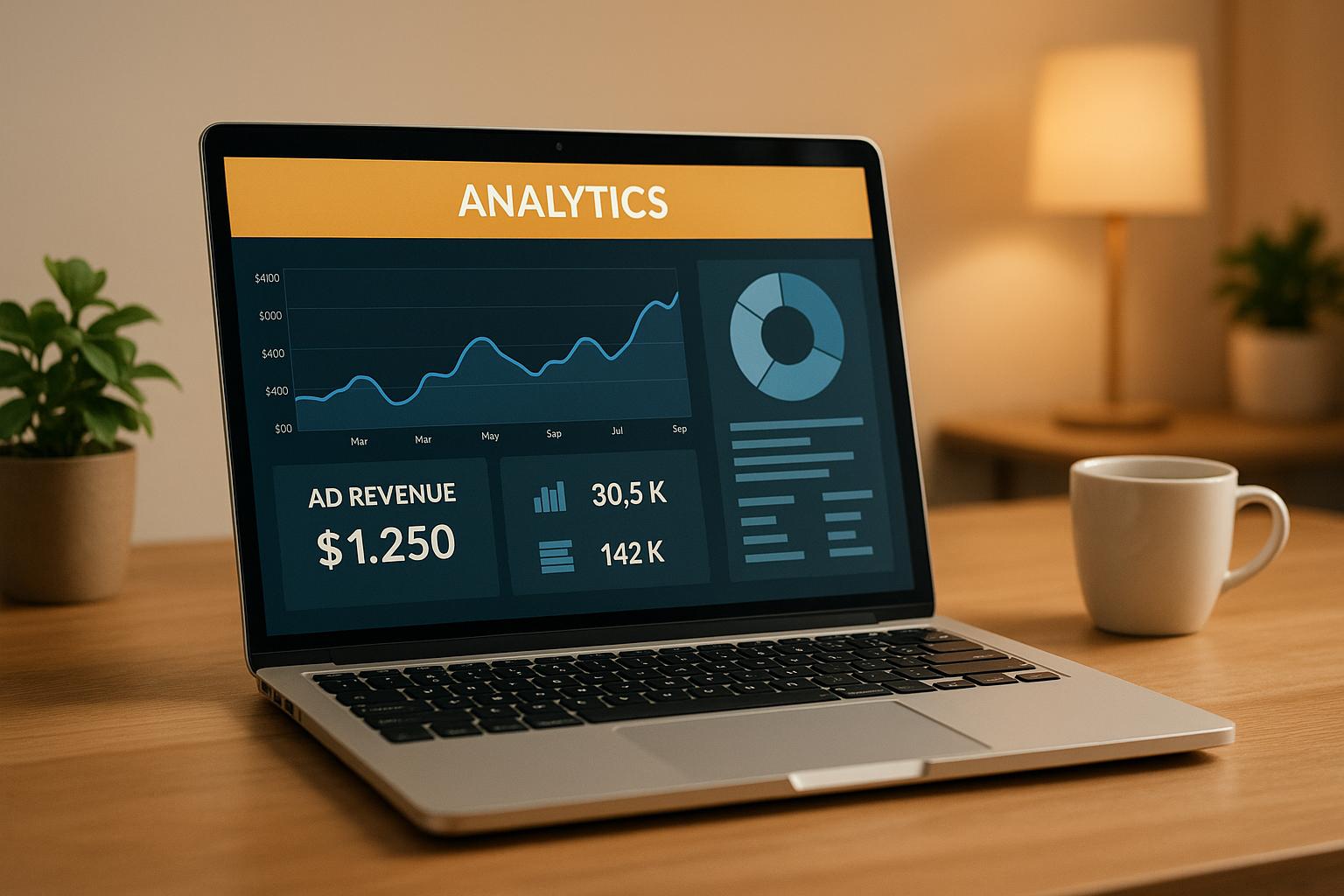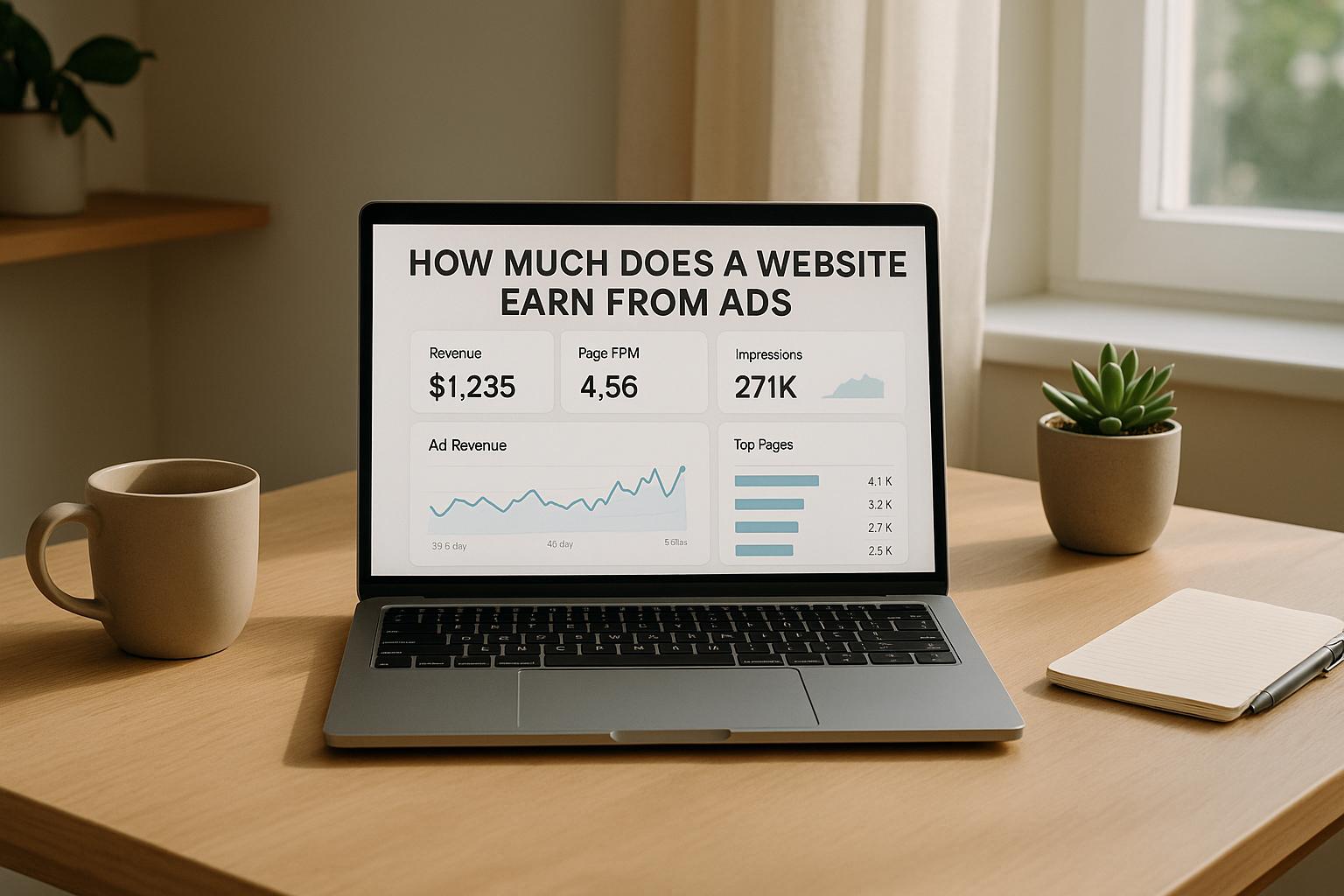Web advertising is essential for publishers to generate revenue while offering free content to users. With nearly 68% of the global population online, understanding ad types and strategies is critical for success. Here’s what you need to know:
- Display Ads: Eye-catching banners, images, and videos that boost brand visibility. They can increase brand awareness by 80% and conversions by 59%.
- Native Ads: Ads that blend into content, achieving 8.8x higher click-through rates and an 18% boost in purchase intent.
- Programmatic Advertising: Automated ad buying using real-time bidding and AI for precise targeting. U.S. programmatic ad spending is projected to reach $98.5 billion in 2024.
Key Takeaways:
- Focus on ad quality and relevance to boost engagement and revenue.
- Tailor ad formats to your audience’s preferences (e.g., mobile users prefer native ads).
- Combine payment models like CPM, CPC, and CPA to diversify income.
Pro Tip: Use tools like TinyAdz to match personalized ads with your niche audience and maximize earnings. Smart strategies and constant testing are the keys to thriving in the evolving digital ad landscape.
How to Sell Ads On Your Website?
Main Types of Web Advertising
Understanding the various forms of web advertising allows publishers to select formats that best suit their audience and revenue objectives. Each type has its own strengths, depending on the nature of your content and the preferences of your visitors.
Display Ads: Eye-Catching Banner Advertising
Display ads rely on visuals to grab attention and promote brands. These ads, which include banners, images, and videos, are strategically placed across websites to boost visibility. Research shows they can increase brand awareness by up to 80% and lead to a 59% rise in conversions. Impressively, the Google Display Network alone reaches about 90% of internet users worldwide.
For example, OKRE Development’s static banner ads and Lufthansa’s animated rich media ads for flight promotions illustrate how effective these ads can be. As Martyna Targosz from Landingi explains:
"Display ads are the type of paid advertising that focuses on visually engaging banners, images, and videos shown across various online channels... These visual ads serve as a crucial tool for brands aiming to enhance their visibility and engagement with target audiences".
To get the most out of display ads, focus on creating compelling visuals and updating them frequently. Rich media ads, in particular, can boost engagement by an impressive 267%. This approach not only improves interaction but also drives revenue.
Next, let’s look at how native ads stand out by blending seamlessly with their surroundings.
Native Ads: Seamlessly Integrated Advertising
Native ads are designed to match the style and function of the platform they appear on, making them less intrusive and more appealing to users. These ads achieve an 8.8x higher click-through rate compared to display ads and lead to an 18% increase in purchase intent.
For publishers targeting niche audiences, native ads are particularly effective. They resonate with the audience by addressing specific needs and preferences. A great example is Fenty Beauty’s collaboration with LGBTQ+ beauty creators, which resulted in engagement rates 3.2x higher than usual. Similarly, REI’s native campaigns generated click-through rates four times higher than the platform's average. As Brandon Keenen, Senior Director at BuzzFeed EMEA, puts it:
"The secret to good native advertising is really being authentic and keeping things real".
To succeed with native ads, ensure your content aligns with the platform's tone and addresses your audience’s interests directly. This strategy not only builds trust but also drives meaningful engagement.
Now, let’s dive into programmatic advertising, which takes personalization to the next level through automation.
Programmatic Advertising: Smarter Ad Delivery with Automation
Programmatic advertising automates the buying and selling of digital ads, ensuring they reach the right audience at the right time using advanced algorithms. Real-Time Bidding (RTB) is a key component, with auctions happening in milliseconds every time a user visits a website or app.
This approach operates on a massive scale. By 2028, global programmatic ad spending is expected to hit $779 billion, while U.S. spending alone is projected to reach $98.5 billion by 2024. Key tools in this system include Demand-Side Platforms (DSPs), Data Management Platforms (DMPs), and Supply-Side Platforms (SSPs).
| Type | Description | Example |
|---|---|---|
| Open Auction (RTB) | Ad spaces available to all; highest bid wins | Competing for ad space on a news website |
| Private Marketplace | Selected advertisers bid for premium spots | A luxury fashion brand on a lifestyle site |
Emerging trends in programmatic advertising include AI-driven optimization and contextual targeting, which offer privacy-friendly alternatives for ad personalization. As Sonali Arya from EasyInsights explains:
"Programmatic advertising transforms ad buying through Real-Time Bidding (RTB) and AI-powered solutions and analytical tools that deliver effective ad placements at peak efficiency".
To make the most of programmatic advertising, publishers should define clear campaign goals, leverage first-party data, and use AI tools to monitor and adjust bids in real time. This ensures better targeting, higher engagement, and increased revenue potential.
How Niche Publishers Can Make More Money
Niche publishers have a unique advantage: advertisers are eager to connect with your specialized audience. The key to boosting revenue lies in tailoring ad formats to match your community’s behavior and leveraging platforms that target your audience effectively.
Let’s dive into how you can align ad formats with your audience’s habits and explore tools like TinyAdz to maximize your earnings.
Matching Ad Formats to Your Audience
The first step to increasing revenue is understanding your audience’s preferences and behavior. Research shows that 81% of Generation Z and 57% of millennials in the U.S. prefer ads that feel personalized to them. To tap into this, use tools like social media and website analytics to study your audience. Are they primarily mobile users scrolling through content on the go, or do they prefer desktop platforms for in-depth reads?
For mobile users, native ads - those that blend seamlessly into content - tend to perform better. On the other hand, desktop users often respond well to strategically placed display ads. Testing different formats can reveal what resonates most. For example, native ads are proven to deliver higher click-through rates, making them a great option for many publishers.
Your website’s layout also plays a big role. It should complement the ad formats you choose. Take inspiration from brands that have successfully tailored their strategies to niche audiences. Xbox Game Pass targeted gaming communities on platforms like Reddit and Discord by collaborating with indie developers and customizing their messages for specific gaming genres. This approach led to a 2.5x increase in subscribers within targeted segments. Similarly, Dunkin’ Donuts used humor-driven memes on subreddits like r/CollegeStudents and r/LateNightSnacks, earning an 82% positive response rate from these communities.
Engaging directly with your audience through surveys, social media polls, or email campaigns can provide valuable insights into what they prefer. Keep an eye on metrics like click-through rates (CTR), conversions, and revenue per thousand impressions (RPM) to fine-tune your strategy over time.
Using TinyAdz for Targeted Revenue

To take your tailored ad strategies to the next level, consider using TinyAdz. This platform specializes in personalized ad placements and verified traffic, ensuring your ads align with your audience’s interests. One of the biggest challenges for niche publishers is finding advertisers who truly understand their audience. TinyAdz bridges that gap with clear reporting and customized advertising solutions, enabling higher-paying campaigns.
The potential revenue boost is impressive. Tailored advertising can make small businesses 16 times more likely to report sales growth. Conversely, failing to align ads with audience interests can cut publisher revenue by up to 52%. TinyAdz offers a variety of monetization options, including banner ads, directory listings, social media integrations, newsletter sponsorships, and even event-based revenue streams. Best of all, there’s no minimum traffic requirement, making it accessible for publishers at any stage of growth.
sbb-itb-957fd63
How to Choose the Right Ad Network
Choosing the right ad network is a game-changer when it comes to boosting revenue. With digital ad spending expected to reach $740 billion by the end of 2025, picking a network that aligns with your audience's needs is essential to stay competitive.
Making the wrong choice can cost you - up to 35% of your budget could be wasted on inefficient bidding. For publishers, that means missed revenue and the risk of losing advertisers.
Matching Ad Formats to Your Website
Start by analyzing your website's traffic patterns and user behavior. This will help you identify which ad formats (banners, video, native) work best with your site’s layout and audience. For example, if your site features lots of visuals, image-based or video ads might grab more attention. On the other hand, if your audience is highly engaged with video content, look for networks that specialize in video ads.
Technical compatibility is another key factor. Check that the ad formats load quickly and integrate seamlessly with your site. Also, make sure the network supports fast, mobile-responsive ads to cater to users on the go.
Protecting your brand’s reputation is crucial. Choose networks with strong brand safety measures to avoid displaying irrelevant or harmful ads that could alienate your audience. Additionally, larger networks often come with more opportunities and better revenue potential, so consider their size, targeting capabilities, and reporting tools.
Once you’ve confirmed the ad network is a good fit in terms of format and technology, it’s time to look at payment models.
Payment Models: CPM, CPC, and CPA Explained
Understanding how payment models work is key to maximizing your earnings. Each model is suited to different types of content and audience behavior, so aligning the right model with your strategy is critical.
| Model | Earnings Basis | Best For | Typical Rates |
|---|---|---|---|
| CPM | Per 1,000 ad impressions | High-traffic sites, brand awareness | $1-$25 per 1,000 impressions |
| CPC | Per click on ads | Engaging content, traffic generation | $0.20-$10 per click |
| CPA | Per specific action (sale, signup) | Niche audiences, high-quality leads | $5-$200 per action |
CPM (Cost Per Mille) offers consistent revenue based on impressions, making it ideal for sites with high traffic. It’s especially effective for brand awareness campaigns. In 2013, 33% of internet ad revenue came from CPM pricing. The low-risk nature of this model means you get paid regardless of user actions.
CPC (Cost Per Click) focuses on engagement. It works well if your content encourages users to click on ads, driving traffic and interaction. This model requires compelling ad placements to succeed.
CPA (Cost Per Action) has the highest earning potential but also the most risk. Payment depends on users completing specific actions, like making a purchase or signing up. Niche publishers with targeted audiences often excel with CPA, as they can deliver high-quality leads. If you can generate valuable conversions, this model can be highly rewarding.
Many publishers combine these models to diversify their revenue streams and meet various advertiser needs. To decide which model suits your site best, consider your audience’s behavior, the type of content you offer, and the goals of your advertisers.
To measure performance across different pricing models, use eCPM (Effective Cost Per Mille). This metric calculates your revenue per 1,000 impressions, regardless of the payment structure, making it a helpful tool for optimizing your ad strategy.
Finally, don’t overlook payment terms. Review revenue share percentages, payment frequency, and minimum payout thresholds to ensure they align with your financial goals. Platforms with reliable support and easy-to-use interfaces can also make managing campaigns much smoother.
The most successful networks allow you to experiment. Regular A/B testing of ad formats, placements, and pricing models can help you fine-tune your strategy based on real-world data. This kind of ongoing optimization is essential for staying ahead in the ever-changing advertising landscape.
Conclusion: Making More Money with Smart Web Advertising
To truly maximize your revenue as a publisher, understanding the nuances of web advertising is key. Did you know that 79% of people prefer ads that are contextually relevant? It's no wonder that native ads - designed to blend seamlessly with content - can boost click-through rates by an impressive 20–60% compared to traditional display ads. Publishers who tailor their ad formats to match their audience's preferences often see far better engagement and results.
But it's not just about the format. Revenue optimization also depends on selecting the right pricing models. Whether it's CPM (cost per thousand impressions), CPC (cost per click), or CPA (cost per acquisition), aligning your model with your audience's behavior is critical. Many publishers find success by mixing models to diversify their income streams and minimize risks.
The advertising world is also shifting toward more personalized and targeted experiences. With contextual ad spending expected to hit $376.2 billion by 2027 and 76% of consumers seeking personalized interactions, relevance has never been more crucial. Meeting these demands can set your business apart.
For niche publishers, platforms like TinyAdz offer a competitive advantage. By focusing on verified human traffic and flexible ad formats, TinyAdz ensures you're not just filling ad space but also running campaigns that resonate with your audience and drive meaningful revenue. Their emphasis on high-value, tailored campaigns makes them a strong ally for publishers looking to stand out.
Thriving in the world of web advertising requires constant experimentation. Testing different ad formats, placements, and pricing models based on real-world performance data is essential for staying ahead of evolving audience preferences and market trends. Digital ad spending continues to grow, and publishers who adapt and refine their strategies will be the ones to succeed.
Ultimately, smart web advertising isn't about finding a one-size-fits-all solution. It's about crafting a strategy that aligns with your audience's needs while ensuring consistent, sustainable revenue for your business.
FAQs
How can publishers choose the best type of web advertising for their audience?
To figure out the most effective type of web advertising, publishers need to start by getting to know their audience. Tools like analytics can help track key details such as demographics, interests, and online behavior. These insights paint a clearer picture of what resonates with users.
From there, experimenting with different ad formats - like display ads, native ads, and programmatic ads - is essential. By testing and analyzing how each type performs in terms of engagement and conversions, publishers can uncover what truly clicks with their audience.
Pairing this data-driven approach with regular testing allows publishers to fine-tune their strategies. This not only keeps users engaged but also helps unlock greater revenue opportunities.
What are the advantages of programmatic advertising for niche publishers, and how is it different from traditional ad buying?
Programmatic advertising brings major benefits to niche publishers, such as better cost management, highly accurate audience targeting, and instant performance tracking. By leveraging real-time bidding to automate the ad buying process, it minimizes manual work while helping publishers connect with their ideal audience at the perfect moment.
Compared to traditional ad buying - which depends on manual negotiations and static ad placements - programmatic advertising is quicker, more scalable, and flexible. This makes it a smart choice for niche publishers aiming to boost ad revenue without losing touch with their specialized audience.
Why should publishers use a mix of payment models like CPM, CPC, and CPA, and how does it affect their revenue?
Using a blend of payment models - CPM (Cost Per Mille), CPC (Cost Per Click), and CPA (Cost Per Action) - is a smart way for publishers to diversify their revenue streams while meeting different advertiser objectives. Here's how each model works: CPM generates steady income based on ad impressions, CPC encourages audience interaction by rewarding clicks, and CPA focuses on high-value actions like purchases or sign-ups.
By combining these approaches, publishers can avoid overdependence on a single income source, stay flexible in a shifting market, and appeal to a broader range of advertisers. This strategy not only increases overall earnings but also ensures a more stable financial foundation in the long run.


